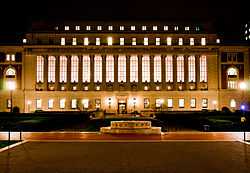Butler Library


Proposed as "South Hall" by the University's former President Nicholas Murray Butler as expansion plans for Low Memorial Library stalled, the new library was funded by Edward Harkness, a Columbia alumnus who was also donor of Yale's residential college system, and designed by his favorite architect, James Gamble Rogers. It was completed in 1934 and renamed for Butler in 1946.
The library's design is neo-classical in style. Its facade features an arcade of columns in the Ionic order above which are inscribed the names of great writers, philosophers, and thinkers, most of whom are read by students engaged in the Core Curriculum of Columbia College.

Butler Library remains at least partially open 24 hours a day during the academic year. Several books and screenplays have been written within its walls, including Nobel Prize-winning novelist Orhan Pamuk's The Black Book and the script for the film Capote. It also plays a role in Paul Auster's 2009 novel Invisible, where the novel's main protagonist, Adam Walker, takes a job as a "page" in the library's stacks. This section of the novel is set in 1967 when the stacks were closed to library users.[1] The page's task was to retrieve requested books from the stacks and re-shelve returned books.
Along the front and sides of the library are inscribed the names of Homer, Herodotus, Sophocles, Plato, Aristotle, Demosthenes, Cicero, Virgil, Horace, Tacitus, Saint Augustine, Aquinas, Dante, Cervantes, Shakespeare, Milton, Voltaire, and Goethe.
References
External links
Coordinates: 40°48′23″N 73°57′47″W / 40.8064°N 73.9631°W
| ||||||||||||||||||||||
